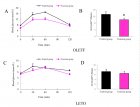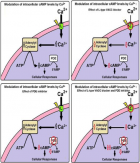Abstract
Research Article
Primer Pairs for Rice (Oryza sativa L.) Bisulfite Sequencing Studies
Mehmet Karaca* and Ayse Gul Ince
Published: 06 November, 2018 | Volume 2 - Issue 3 | Pages: 091-098
Many agriculturally important properties such as heterosis, inbreeding depression, phenotypic plasticity, and resistance for biotic and abiotic stresses are thought to be affected with epigenetic components. New discoveries related with epigenetics are likely to have a major impact on strategies for crop improvement in rice breeding. However, assessing the contribution of epigenetics to heritable variation in plant species still poses major challenges. Methylation of cytosine in DNA is one of the most important epigenetic mechanisms in plants. DNA methylation not only plays significant roles in the regulation of gene activity, but also it is related with genomic integrity. Although most of next generation sequencing (NGS) technologies do not require the use of target specific primer pairs to identify and study DNA cytosine methylation, validation studies of NGS uses selective primer pairs. Bisulfite sequencing technique is a gold method for DNA cytosine methylation studies. However, bisulfite sequencing requires the development of bisulfite primer pairs to selectively study DNA sequences of interest. In this study 9 bisulfite specific primer pairs were identified and validated. These primer pairs successfully amplified bisulfite converted and unconverted genomic DNA extracted from radicle and plumule of rice (Oryza sativa L.) seedlings. Results of the present study clearly revealed the occurrence of CG, CHG and CHH (H stands for C. T or A nucleotides) contents in studied DNA sequence targets were different indicating potential role of DNA cytosine methylation in these genes. Primer pairs reported in this study could be used to detect DNA methylation which is one of the most important epigenetic mechanisms affecting the development, differentiation or the response to biotic and abiotic stress in rice (Oryza sativa L.).
Read Full Article HTML DOI: 10.29328/journal.jpsp.1001024 Cite this Article Read Full Article PDF
Keywords:
Differential methylation; Epigenetics; Gene element; Promoter; Touch-down PCR
References
- Guo L, Liu M, Zhang Y, Tao Y, Zhang F, et al. Yield differences get large with ascendant altitude between traditional paddy and water-saving ground cover rice production system. European Journal of Agronomy. 2018; 92: 9–16. Ref.: https://goo.gl/T9AVoZ
- Anonymous, USDA Foreign Agricultural Service, Global Agricultural Information Network Report. 2017; No: TR7014. Ref.: https://goo.gl/44h7Dc
- Anonymous, FAOSTAT Food Agricultural Organization. 2018; UN. Ref.: http://faostat.fao.org/
- Deng X, Song X, Wei L, Liu C, Cao W. Epigenetic regulation and epigenomic landscape in rice. National Science Review. 2016; 3: 309–327. Ref.: https://goo.gl/cwtgTq
- Law JA, Jacobsen SE. Establishing, maintaining and modifying DNA methylation patterns in plants and animals. Nature Reviews Genetics. 2010; 11: 204-220. Ref.: https://goo.gl/73Le67
- Shen H, He H, Li J, Chen W, Wang X, et al. Genome-wide analysis of DNA methylation and gene expression changes in two Arabidopsis ecotypes and their reciprocal hybrids. Plant Cell. 2012; 24: 875-892. Ref.: https://goo.gl/WQyeY6
- Peng H, Zhang J. Plant genomic DNA methylation in response to stresses: potential applications and challenges in plant breeding. Progress in Natural Science. 2009; 19: 1037-1045. Ref.: https://goo.gl/Cs1Y5Z
- Karaca M, Ince AG. EpiOne: A software tool for identification of potential cytosine DNA methylation marks in promoters and gene bodies. Journal of Scientific and Engineering Research. 2016; 3: 295-301. Ref.: https://goo.gl/Jpt7Nx
- Jin X, Pang Y, Jia F, Xiao G, Li Q, Zhu Y. A potential role for CHH DNA methylation in cotton fiber growth patterns. PLoS ONE. 2013; 8: e60547. Ref.: https://goo.gl/AAwGBH
- Rozen S, Skaletsky H. Primer3 on the WWW for general users and for biologist programmers. Methods in Molecular Biology. 200; 132: 365-386. Ref.: https://goo.gl/fSisb9
- Karaca M, Ince AG, Elmasulu SY, Onus AN, Turgut K. Coisolation of genomic and organelle DNAs from 15 genera and 31 species of plants. Anal Biochem. 2005; 343: 353-355. Ref.: https://goo.gl/NGZn1Y
- Karaca M, Ince AG, Uygur-Gocer E, Aydin A. Bisulfite primer pairs for analysis of cotton (Gossypium spp.) DNA methylation. Journal of Scientific and Engineering Research. 2016; 3: 656-662. Ref.: https://goo.gl/VPJcV6
- Gruntman E, Qi Y, Slotkin RK, Roeder T, Martienssen RA, Sachidanandam R. Kismeth: analyzer of plant methylation states through bisulfite sequencing. BMC Bioinformatics. 2008; 9: 371. Ref.: https://goo.gl/9qVRHL
- Bewick, AJ, Schmitz RJ. Gene body DNA methylation in plants. Current Opinion in Plant Biology. 2017; 36: 103-110. Ref.: https://goo.gl/Yfb22X
- Yonekura M, Aoki N, Hirose T, Onai K, Ishiura M, et al. The promoter activities of sucrose phosphate synthase genes in rice, OsSPS1 and OsSPS11, are controlled by light and circadian clock, but not by sucrose. Frontiers in Plant Science. 2013; 4:31. Ref.: https://goo.gl/gcEN6h
- Nelson AJ, Doerner PW, Zhu Q, Lamb C. Isolation of a monocot 3-hydroxy-3-methylglutaryl coenzyme A reductase gene that is elicitor-inducible. Plant Molecular Biology. 1994; 25: 401-412. Ref.: https://goo.gl/AppLJJ
- Liu DR, Huang WX, Cai XL. Oligomerization of rice granule-bound starch synthase I modulates its activity regulation. Plant Science. 2013; 210: 141-150. Ref.: https://goo.gl/wo9Vad
- Ince AG, Karaca M, Uygur Gocer E, Aydin A. Descriptive statistics and PIC values of genomic-and transcriptomic-microsatellites in several plant species. Journal of Scientific and Engineering Research. 2017; 4:236-246. Ref.: https://goo.gl/cLGgeS
- Chen X, Zhou DX. Rice epigenomics and epigenetics: challenges and opportunities. Curr Opin Plant Biol. 2013; 16:164-169. Ref.: https://goo.gl/Y9qAqr
Figures:

Figure 1
Similar Articles
-
Impact of Calcium Phosphate Nanoparticles on Rice PlantHrishikesh Upadhyaya*,Lutfa Begum,Bishal Dey,P K Nath,S K Panda. Impact of Calcium Phosphate Nanoparticles on Rice Plant. . 2017 doi: 10.29328/journal.jpsp.1001001; 1: 001-010
-
HBV: Genomic Structure, HBVsAg Isolation and innovative Virotherapy Initiation in the Middle EastAboul-Ata E Aboul-Ata*,Essam M Janahi,I M El-Kalamawy,Kathleen Hefferon,Amal Mahmoud. HBV: Genomic Structure, HBVsAg Isolation and innovative Virotherapy Initiation in the Middle East . . 2017 doi: 10.29328/journal.jpsp.1001007; 1: 059-061
-
Primer Pairs for Rice (Oryza sativa L.) Bisulfite Sequencing StudiesMehmet Karaca*,Ayse Gul Ince. Primer Pairs for Rice (Oryza sativa L.) Bisulfite Sequencing Studies. . 2018 doi: 10.29328/journal.jpsp.1001024; 2: 091-098
Recently Viewed
-
Synthesis of Carbon Nano Fiber from Organic Waste and Activation of its Surface AreaHimanshu Narayan*,Brijesh Gaud,Amrita Singh,Sandesh Jaybhaye. Synthesis of Carbon Nano Fiber from Organic Waste and Activation of its Surface Area. Int J Phys Res Appl. 2019: doi: 10.29328/journal.ijpra.1001017; 2: 056-059
-
Obesity Surgery in SpainAniceto Baltasar*. Obesity Surgery in Spain. New Insights Obes Gene Beyond. 2020: doi: 10.29328/journal.niogb.1001013; 4: 013-021
-
Tamsulosin and Dementia in old age: Is there any relationship?Irami Araújo-Filho*,Rebecca Renata Lapenda do Monte,Karina de Andrade Vidal Costa,Amália Cinthia Meneses Rêgo. Tamsulosin and Dementia in old age: Is there any relationship?. J Neurosci Neurol Disord. 2019: doi: 10.29328/journal.jnnd.1001025; 3: 145-147
-
Case Report: Intussusception in an Infant with Respiratory Syncytial Virus (RSV) Infection and Post-Operative Wound DehiscenceLamin Makalo*,Orlianys Ruiz Perez,Benjamin Martin,Cherno S Jallow,Momodou Lamin Jobarteh,Alagie Baldeh,Abdul Malik Fye,Fatoumatta Jitteh,Isatou Bah. Case Report: Intussusception in an Infant with Respiratory Syncytial Virus (RSV) Infection and Post-Operative Wound Dehiscence. J Community Med Health Solut. 2025: doi: 10.29328/journal.jcmhs.1001051; 6: 001-004
-
The prevalence and risk factors of chronic kidney disease among type 2 diabetes mellitus follow-up patients at Debre Berhan Referral Hospital, Central EthiopiaGetaneh Baye Mulu,Worku Misganew Kebede,Fetene Nigussie Tarekegn,Abayneh Shewangzaw Engida,Migbaru Endawoke Tiruye,Mulat Mossie Menalu,Yalew Mossie,Wubshet Teshome,Bantalem Tilaye Atinafu*. The prevalence and risk factors of chronic kidney disease among type 2 diabetes mellitus follow-up patients at Debre Berhan Referral Hospital, Central Ethiopia. J Clini Nephrol. 2023: doi: 10.29328/journal.jcn.1001104; 7: 025-031
Most Viewed
-
Evaluation of Biostimulants Based on Recovered Protein Hydrolysates from Animal By-products as Plant Growth EnhancersH Pérez-Aguilar*, M Lacruz-Asaro, F Arán-Ais. Evaluation of Biostimulants Based on Recovered Protein Hydrolysates from Animal By-products as Plant Growth Enhancers. J Plant Sci Phytopathol. 2023 doi: 10.29328/journal.jpsp.1001104; 7: 042-047
-
Sinonasal Myxoma Extending into the Orbit in a 4-Year Old: A Case PresentationJulian A Purrinos*, Ramzi Younis. Sinonasal Myxoma Extending into the Orbit in a 4-Year Old: A Case Presentation. Arch Case Rep. 2024 doi: 10.29328/journal.acr.1001099; 8: 075-077
-
Feasibility study of magnetic sensing for detecting single-neuron action potentialsDenis Tonini,Kai Wu,Renata Saha,Jian-Ping Wang*. Feasibility study of magnetic sensing for detecting single-neuron action potentials. Ann Biomed Sci Eng. 2022 doi: 10.29328/journal.abse.1001018; 6: 019-029
-
Pediatric Dysgerminoma: Unveiling a Rare Ovarian TumorFaten Limaiem*, Khalil Saffar, Ahmed Halouani. Pediatric Dysgerminoma: Unveiling a Rare Ovarian Tumor. Arch Case Rep. 2024 doi: 10.29328/journal.acr.1001087; 8: 010-013
-
Physical activity can change the physiological and psychological circumstances during COVID-19 pandemic: A narrative reviewKhashayar Maroufi*. Physical activity can change the physiological and psychological circumstances during COVID-19 pandemic: A narrative review. J Sports Med Ther. 2021 doi: 10.29328/journal.jsmt.1001051; 6: 001-007

HSPI: We're glad you're here. Please click "create a new Query" if you are a new visitor to our website and need further information from us.
If you are already a member of our network and need to keep track of any developments regarding a question you have already submitted, click "take me to my Query."





















































































































































